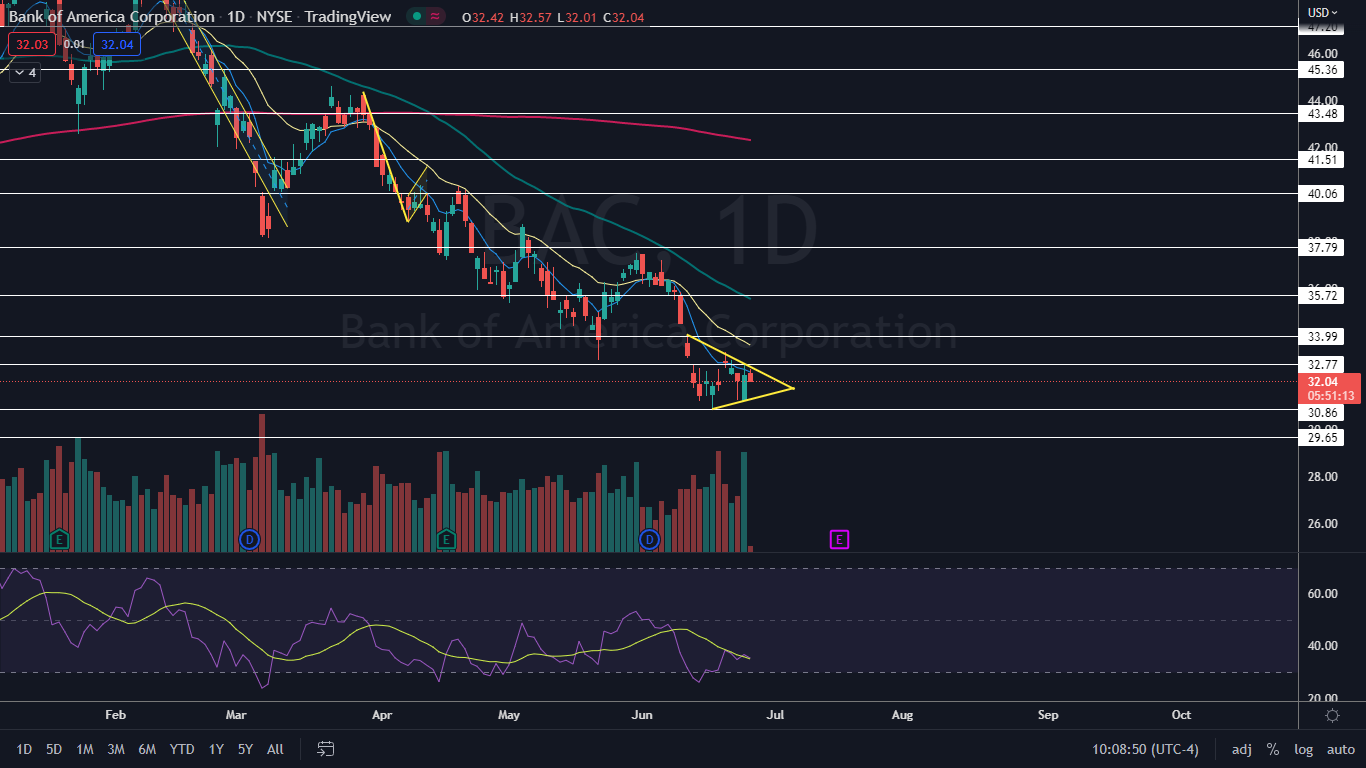
Bank of America Corporation (NYSE:BAC) was trading slightly lower on Monday after a bullish day on Friday saw the stock rally 3.39%.
Bank of America has been trading mostly sideways for the past eight trading days, in consolidation after plunging almost 17% lower between June 1 and June 14. The horizontal action has settled the stock into a symmetrical triangle pattern on the daily chart, which has both a bull and a bear case for future direction.
A symmetrical triangle pattern is created when a stock forms a series of lower highs and higher lows between a descending and an ascending trendline, which meet on the right side of the chart to form an apex. The pattern indicates that the bulls and bears are equally in control.
A symmetrical triangle is often formed on lower-than-average volume and demonstrates a decrease in volatility, indicating consolidation. The decreasing volume is often followed by a sharp increase in volume when the stock breaks up or down from the pattern, which should happen before the stock reaches the apex of the triangle.
- Aggressive bullish traders may choose to purchase a stock in a symmetrical triangle when the security reverses course on the lower ascending trendline, with a stop set if the stock rejects at the upper descending trendline of the pattern. More conservative traders may wait for the stock to break up bullishly from the pattern on higher-than-average volume.
- Aggressive bearish traders may choose to trade opposite to the bulls, entering into a short position on a rejection of the upper descending trendline and covering the position if the stock finds support at the lower trendline. Opposite to the bulls, conservative bearish traders may wait for the stock to break down from the lower trendline on higher-than-average bearish volume.
Want direct analysis? Find me in the BZ Pro lounge! Click here for a free trial.
The Bull Case for Bank of America: Within the symmetrical triangle pattern, Bank of America was developing an inside bar pattern on Monday, which leans bullish because the stock was trading higher before forming the pattern and the inside bar was being created near the top of Friday’s range. If Bank of America breaks bullishly from the mother bar later on Monday or on Tuesday, the stock will also break up from the triangle pattern, which could indicate a larger reversal to the upside is in the cards.
Traders and investors will want to see the bullish break from the inside bar and symmetrical triangle patterns take place on higher-than-average volume on lower timeframes as an indication the patterns were recognized.
There is resistance above at $32.77 and $33.99.
See Also: How to Read Candlestick Charts for Beginners
The Bear Case for Bank of America: The symmetrical triangle, paired with the drop prior to the pattern forming, could have settled Bank of America into a bear flag pattern, with the pole formed between June 6 and June 14 and the flag created over the trading days that have followed. If the bear flag becomes the dominate pattern, the measured move could drop Bank of America down toward the $27.50 level.
Bank of America is also trading below the eight-day and 21-day exponential moving averages (EMAs), with the eight-day EMA trending below the 21-day, both of which are bearish indicators. If the stock is unable to regain the two moving averages as support, it becomes more likely the indicators will continue to push the stock lower until a bearish break takes place.
Bank of America has support below at $30.86 and $29.65.








